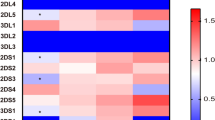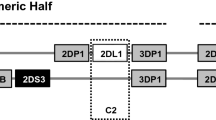Abstract
Natural killer (NK) cells play a key role in defense against tumor cells that have the capacity to downregulate human leukocyte antigen (HLA) class I expression. It has been reported that leukemic cells can have downregulated expression of HLA class I molecules. The polymorphic nature of NK cell receptor (NKR) genes generates diverse repertoires in the human population, which display specificity in the innate immune response. In the present study, 11 KIR and two CD94/NKG2 receptors were genotyped by PCR-SSP in 96 leukemic patients and 148 healthy Caucasians. Here, we report a significant increased frequency of the more inhibitory AB killer cell immunoglobulin-like receptor (KIR) phenotype in leukemic patients compared to the controls (31.1% in healthy controls vs 51.0% in leukemic patients, Pc=0.002), which is related to the high prevalence of the inhibitory KIR2DL2 in this population (Pc=0.007). Moreover, two specific KIR phenotypes AB1 and AB9, including all inhibitory KIRs, were significantly associated with leukemic patients. Our study suggests that an important percentage of leukemic patients express a KIR phenotype in favor of escape from NK cell immunity.
This is a preview of subscription content, access via your institution
Access options
Subscribe to this journal
Receive 12 print issues and online access
$259.00 per year
only $21.58 per issue
Buy this article
- Purchase on Springer Link
- Instant access to full article PDF
Prices may be subject to local taxes which are calculated during checkout

Similar content being viewed by others
References
Trinchieri G . Biology of natural killer cells. Adv Immunol 1989; 47: 187–376.
Uharek L, Zeis M, Glass B, Steinmann J, Dreger P, Gassmann W et al. High lytic activity against human leukemia cells after activation of allogeneic NK cells by IL-12 and IL-2. Leukemia 1996; 10: 1758–1764.
Lotzova E, Savary CA, Herberman RB . Inhibition of clonogenic growth of fresh leukemia cells by unstimulated and IL-2 stimulated NK cells of normal donors. Leuk Res 1987; 11: 1059–1066.
Ljunggren HG, Karre K . In search of the ‘missing self’: MHC molecules and NK cell recognition. Immunol Today 1990; 11: 237–244.
Dohring C, Colonna M . Major histocompatibility complex (MHC) class I recognition by natural killer cells. Crit Rev Immunol 1997; 17: 285–299.
Long EO . Regulation of immune responses through inhibitory receptors. Annu Rev Immunol 1999; 17: 875–904.
Martin AM, Freitas EM, Witt CS, Christiansen FT . The genomic organization and evolution of the natural killer immunoglobulin-like receptor (KIR) gene cluster. Immunogenetics 2000; 51: 268–280.
Colonna M, Brooks EG, Falco M, Ferrara GB, Strominger JL . Generation of allospecific natural killer cells by stimulation across a polymorphism of HLA-C. Science 1993; 260: 1121–1124.
Moretta A, Vitale M, Bottino C, Orengo AM, Morelli L, Augugliaro R et al. p58 molecules as putative receptors for major histocompatibility complex (MHC) class I molecules in human natural killer (NK) cells: Anti-p58 antibodies reconstitute lysis of MHC class I-protected cells in NK clones displaying different specificities. J Exp Med 1993; 178: 597–604.
Gumperz JE, Litwin V, Phillips JH, Lanier LL, Parham P . The Bw4 public epitope of HLA-B molecules confers reactivity with natural killer cell clones that express NKB1, a putative HLA receptor. J Exp Med 1995; 181: 1133–1144.
Döhring C, Scheidegger D, Samaridis J, Cella M, Colonna M . A human killer inhibitory receptor specific for HLA-A1,2. J Immunol 1996; 156: 3098–3101.
Uhrberg M, Valiante NM, Shum BP, Shilling HG, Lienert-Weidenbach K, Corliss B et al. Human diversity in killer cell inhibitory receptor genes. Immunity 1997; 7: 753–763.
Witt CS, Dewing C, Sayer DC, Uhrberg M, Parham P . Population frequencies and putative haplotypes of the killer cell immunoglobulin-like receptor sequences and evidence for recombination. Transplantation 1999; 68: 1784–1789.
Chang C, Rodriguez A, Carretero M, Lopez-Botet M, Phillips JH, Lanier LL . Molecular characterization of human CD94: a type II membrane glycoprotein related to the C-type lectin superfamily. Eur J Immunol 1995; 25: 2433–2437.
Lazetic S, Chang C, Houchins JP, Lanier LL, Phillips JH . Human natural killer cell receptors involved in MHC class I recognition are disulfide-linked heterodimers of CD94 and NKG2 subunits. J Immunol 1996; 157: 4741–4745.
Braud VM, Allan DS, O'Callaghan CA, Soderstrom K, D'Andrea A, Ogg GS et al. HLA-E binds to natural killer cell receptors CD94/NKG2A, B and C. Nature 1998; 391: 795–799.
Demanet C, Mulder A, Deneys V, Worsham MJ, Maes P, Claas FH et al. Down-regulation of HLA-A and HLA-Bw6, but not HLA-Bw4, allospecificities in leukemic cells: an escape mechanism from CTL and NK attack? Blood 2004; 103: 3122–3130.
Elkins WL, Pickard A, Pierson GR . Deficient expression of class-I HLA in some cases of acute leukemia. Cancer Immunol Immunother 1984; 18: 91–100.
Brouwer RE, van der Heiden P, Schreuder GM, Mulder A, Datema G, Anholts JD et al. Loss or downregulation of HLA class I expression at the allelic level in acute leukemia is infrequent but functionally relevant, and can be restored by interferon. Hum Immunol 2002; 63: 200–210.
Vollmer M, Li L, Schmitt A, Greiner J, Reinhardt P, Ringhoffer M et al. Expression of human leucocyte antigens and co-stimulatory molecules on blasts of patients with acute myeloid leukaemia. Br J Haematol 2003; 120: 1000–1008.
Jiang YZ, Barrett AJ, Goldman JM, Mavroudis DA . Association of natural killer cell immune recovery with a graft-versus-leukemia effect independent of graft-versus-host disease following allogeneic bone marrow transplantation. Ann Hematol 1997; 74: 1–6.
Ruggeri L, Capanni M, Casucci M, Volpi I, Tosti A, Perruccio K et al. Role of natural killer cell alloreactivity in HLA-mismatched hematopoietic stem cell transplantation. Blood 1999; 94: 333–339.
Ruggeri L, Capanni M, Urbani E, Perruccio K, Shlomchik WD, Tosti A et al. Effectiveness of donor natural killer cell alloreactivity in mismatched hematopoietic transplants. J Clin Invest 1998; 101: 1835–1842.
Toneva M, Lepage V, Lafay G, Dulphy N, Busson M, Lester S et al. Genomic diversity of natural killer cell receptor genes in three populations. Tissue Antigens 2001; 57: 358–362.
Gomez-Lozano N, Vilches C . Genotyping of human killer-cell immunoglobulin-like receptor genes by polymerase chain reaction with sequence-specific primers: an update. Tissue Antigens 2002; 59: 184–193.
Norman PJ, Stephens HA, Verity DH, Chandanayingyong D, Vaughan RW . Distribution of natural killer cell immunoglobulin-like receptor sequences in three ethnic groups. Immunogenetics 2001; 52: 195–205.
Niokou D, Spyropoulou-Vlachou M, Darlamitsou A, Stavropoulos-Giokas C . Distribution of killer cell immunoglobulin-like receptors in the Greek population. Hum Immunol 2003; 64: 1167–1176.
Mattiuz L, Ihde D, Piazza A, Ceppellini R, Bodmer WF . New approaches to the population genetic and segregation analysis of the HLA system. In: Terasaki PI (ed). Histocompatibility Testing 1970. Munskaard: Copenhagen, 1971, 193.
Crum KA, Logue SE, Curran MD, Middleton D . Development of a PCR-SSOP approach capable of defining the natural killer cell inhibitory receptor (KIR) gene sequence repertoires. Tissue Antigens 2000; 56: 313–326.
Rajalingam R, Krausa P, Shilling HG, Stein JB, Balamurugan A, McGinnis MD et al. Distinctive KIR and HLA diversity in a panel of north Indian Hindus. Immunogenetics 2002; 53: 1009–1019.
Chiorean EG, Dylla SJ, Olsen K, Lenvik T, Soignier Y, Miller JS . BCR/ABL alters the function of NK cells and the acquisition of killer immunoglobulin-like receptors (KIRs). Blood 2003; 101: 3527–3533.
Costello RT, Sivori S, Marcenaro E, Lafage-Pochitaloff M, Mozziconacci MJ, Reviron D et al. Defective expression and function of natural killer cell-triggering receptors in patients with acute myeloid leukemia. Blood 2002; 99: 3661–3667.
Acknowledgements
We gratefully thank all volunteers who donated blood samples for this study. We wish to thank the biomedical student Tina Lamberts for help in genotyping KIRs and Brigitte Guns for editing of the manuscript. This work was supported by a grant from the Scientific Fund W Gepts AZ-VUB. We also thank the voluntary organization ‘Mensen Helpen Mensen’ for their generous gifts and their support to cancer patients.
Author information
Authors and Affiliations
Corresponding author
Rights and permissions
About this article
Cite this article
Verheyden, S., Bernier, M. & Demanet, C. Identification of natural killer cell receptor phenotypes associated with leukemia. Leukemia 18, 2002–2007 (2004). https://doi.org/10.1038/sj.leu.2403525
Received:
Accepted:
Published:
Issue Date:
DOI: https://doi.org/10.1038/sj.leu.2403525
Keywords
This article is cited by
-
KIR-HLA gene diversities and susceptibility to lung cancer
Scientific Reports (2022)
-
Natural killer cells and acute myeloid leukemia: promises and challenges
Cancer Immunology, Immunotherapy (2022)
-
Coexistence of inhibitory and activating killer-cell immunoglobulin-like receptors to the same cognate HLA-C2 and Bw4 ligands confer breast cancer risk
Scientific Reports (2021)
-
Inhibitory KIR2DL2 Gene: Risk for Deep Endometriosis in Euro-descendants
Reproductive Sciences (2021)
-
Current progress in NK cell biology and NK cell-based cancer immunotherapy
Cancer Immunology, Immunotherapy (2020)



